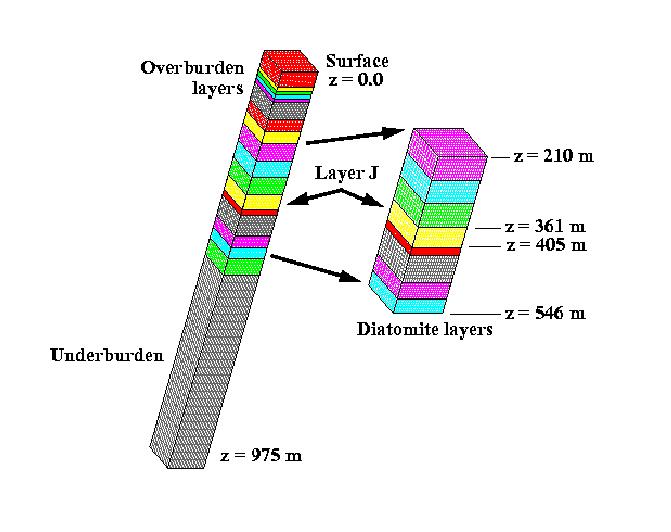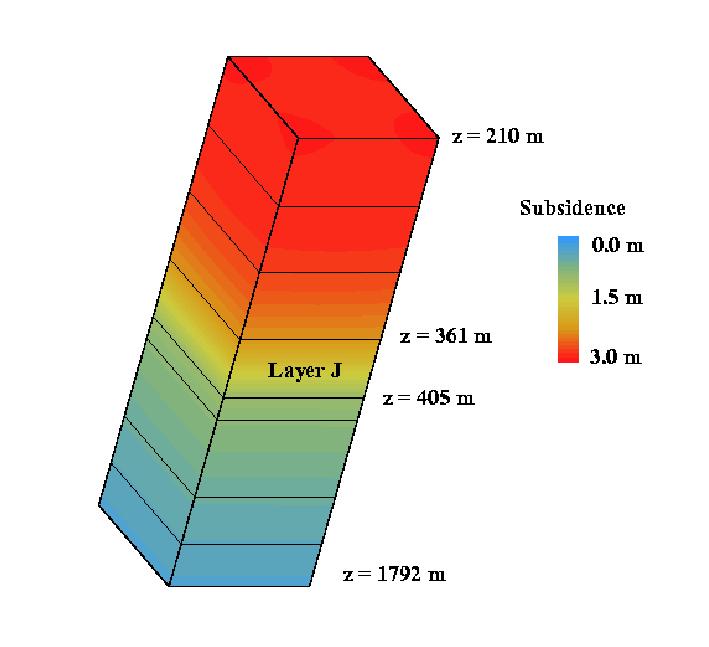The motivation for this development is that traditional flow simulations in compactible reservoirs, such as Ekofisk in the North Sea and Belridge in California, cannot produce accurate results unless one accounts for mechanical changes in reservoir geology. Moreover, for this modeling to have a meaningful impact, the coupled fluid flow/geomechanics simulation must allow for two-way passage of information.
A second motivation for this work is that it will enable researchers to account for rock density changes in time-lapse seismic imaging. Most 4-D seismic techniques attribute all time-dependent reservoir differences to changes in pressure, saturation, and temperature. Neglecting compaction when modeling weak-formation reservoirs may introduce serious errors in the seismic properties.
Project Results
This project demonstrated that it is possible to loosely couple together two existing analysis codes and accurately model complex nonlinear phenomena often observed in the field. Numerical results using the coupled code showed that coupled flow and deformation calculations, for the Belridge oilfield near Bakersfield, CA, produced compressional wave velocities that differ markedly from those based on the flow solution alone. This is an important result when using time-lapse seismic techniques for accurately imaging production reservoirs.
Benefits
This work highlights the need for performing coupled flow/geomechanics calculations for highly compactible reservoirs by the oil and gas industry. Oil industry reservoir engineers need accurate imaging information in order to improve their understanding of the oil and gas distribution within the reservoir. Currently, most time-lapse seismic techniques attribute all time-dependent reservoir differences to changes in pressure, saturation, and temperature; however, neglecting compaction when modeling weak-formation reservoirs may introduce serious errors in the seismic properties. This work showed that this information may be obtained relatively quickly and inexpensively by coupling together two independent fluid flow and geomechanics simulators. This work also demonstrated the feasibility and accuracy of a two-way staggered-in-time coupling scheme.
Project Summary
Accurate prediction of reservoir production in structurally weak geologic areas requires both mechanical deformation and fluid flow modeling. Loose staggered-in-time coupling of two independent flow and mechanics simulators captures much of the complex physics at a substantially reduced cost.
Two 3-D finite-element simulators-Integrated Parallel Accurate Reservoir Simulator (IPARS) from the University of Texas for flow and JAS3D from SNL for mechanics-together model multiphase fluid flow in reservoir rocks undergoing deformation ranging from linear elasticity to large, nonlinear inelastic compaction. Pore pressures from flow are used as loads for the geomechanics code in the determination of stresses, strains, and displacements. The mechanics-derived strain is used to calculate changes to the reservoir parameters (porosity and permeability) for the next set of flow time steps. An approximate rock compressibility parameter is used as a preconditioner to help with convergence of the modified flow equations.
Two numerical experiments illustrate the accuracy of the coupled code. The first example is a quarter-five-spot waterflood undergoing poroelastic deformation, which is validated against a fully coupled simulator. Vertical displacements at the well locations match to within 10%. Moreover, experimentation shows that 13 mechanics time steps (taken over the course of 5 years of simulation time) were sufficient to achieve this result (a substantial cost savings over full coupling, in which both the mechanics and flow equations must be solved at each time step).
The second numerical example is based on real data from Belridge field in California, which illustrates one of the complex plastic constitutive relationships available in the coupled code. The results mimic behavior that was observed in the field. The coupled code serves as a prototype for loosely coupling together any two existing simulators modeling diverse physics. This technique produces a coupled code relatively quickly and inexpensively and has the advantage of accurately modeling complex nonlinear phenomena often observed in a real field but difficult to capture with a fully coupled simulator. Further, the code has produced promising results when used for seismic time-lapse studies of compactible reservoirs.
Project researchers have:
- Written a high-level driver to couple together two independent simulators (IPARS and JAS3D).
- Analyzed numerical techniques for improving robustness and speed of the flow solver when reservoir porosity and permeability change dynamically during flow simulation.
- Implemented a scheme for adaptively controlling time-stepping between the two simulators.
- Run realistic Belridge Field data experiments-a simple experiment with a single material layer and a complex experiment with 18 different material layers.
- Performed the first time-lapse seismic analysis using coupled flow/mechanics simulation (Belridge single layer). Flow/mechanics input produced noticeable changes in reservoir rock densities for seismic.





